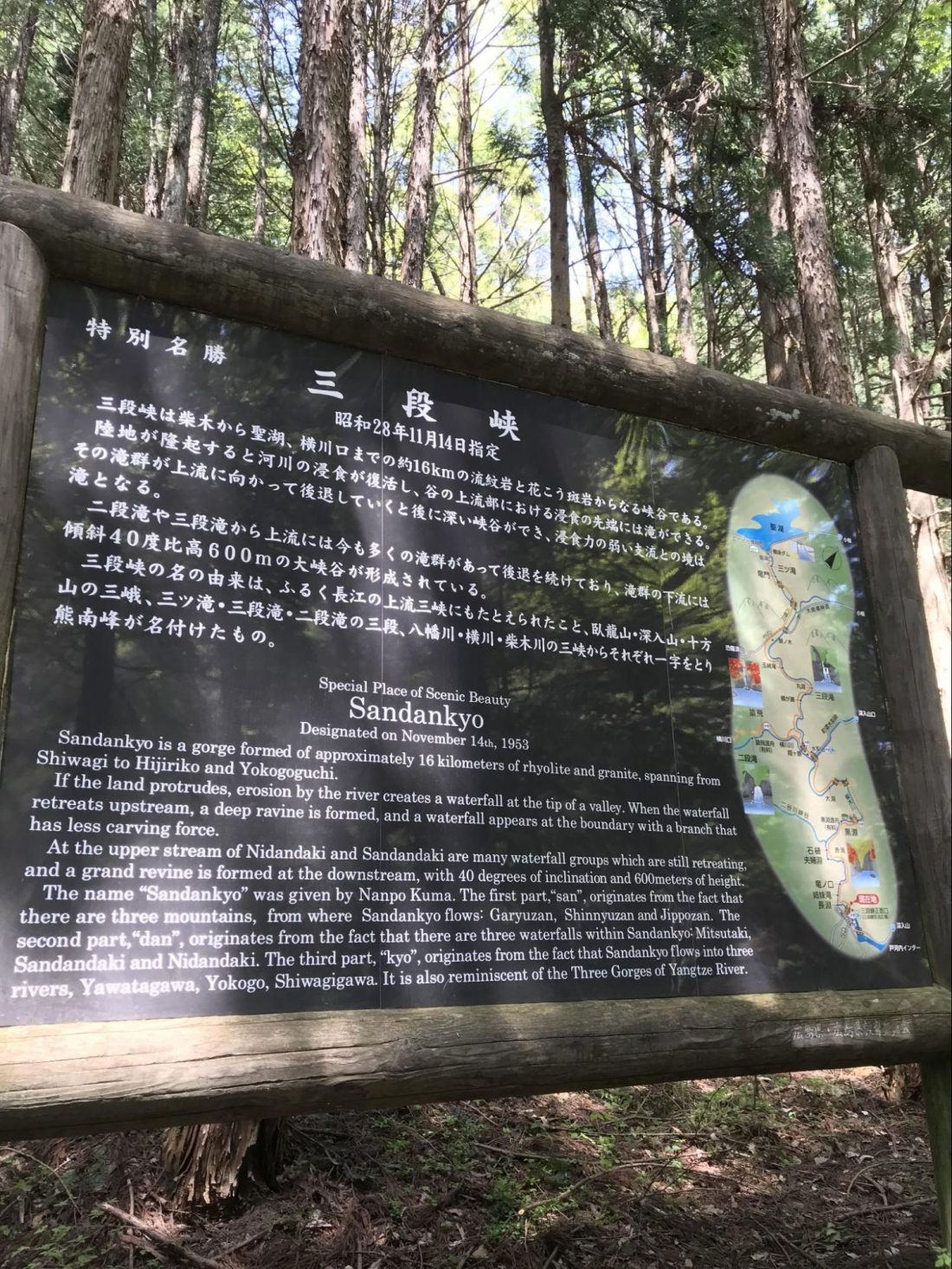100 Stories
Sandan-Kyo: Three Rivers Gorge
If you want to get outdoors and explore the Hiroshima Prefecture area, while experiencing the beautiful offerings of nature that Japan has to offer, then I strongly suggest a trip to a very special place just north of the Hiroshima city limits for a hike to remember. The place is called Sandankyo or Three Rivers Gorge. It is located about 45 kilometers from the city limits or about 75 minutes travel time; and is easily accessible by either bus or car. This place is a hidden gem that you must see to believe. Gorgeous scenery with flora and fauna that will take you away from the sights and sounds of the big city life in Hiroshima to a place that will fill your senses with the bountiful joys of the natural world.
Directions
There are two basic ways to get there: by car or bus.
- Bus: From Hiroshima Station please take any of the following streetcars: the number 1, 2, or 6 streetcars (cost is about 150 yen). Get off at the Kamiyacho Station stop just in front of the Sogo Department Store; this is where the Hiroshima City Bus Terminal is located on the third floor. Then purchase a ticket for bus number 7 to the Sandan-Kyo Gorge (cost is about 1440 yen for a one way trip and 2880 yen for a round trip).
NOTE: The bus currently leaves only once per day (everyday) at 8:18AM (recommend you check at the bus terminal for any time changes or cancellations before you go).
The bus is scheduled to arrive at Sandan-Kyo bus stop around 9:33AM, so the one way trip takes about 1 hour and 15 minutes to the gorge hiking area entrance.
NOTE: The return bus to Hiroshima Station leaves at 3:00PM from the same bus stop you got off from, and will drop you off in front of Hiroshima Station at around 4:20PM. Again, keep in mind that this is the only return bus for the day!
- Car: The simplest and fastest route involves tolls and takes about 75-90 minutes from Hiroshima Station. To start, please head north west out of the city towards the Chugoku Expressway for Hamada/Miyoshi. At the Hiroshima Junction, please head towards Yamaguchi and then take the Togouchi Interchange for Kake/Togouchi/Tsutsuga and get off at the Togouchi exit and route 191 (drive for around 7km) and then turn onto route 249 (drive for about 1km). From there follow the signs to the Sandan-Kyo area. It costs 400 yen to park your car at the entrance to the park.
NOTE: There may be an additional parking area about 1KM from the park entrance (it appeared to have free parking, but you would have to stop to check – I did not stop); but of course you must walk the 1KM to the park entrance.
Togouchi Michi No Eki Interchange Rest Stop
If you decide to go by car, when you exit the highway you will come to the Togouchi Interchange Rest Area. This location is quite lively and busy with plenty of area information of what to see and do in the area
(an English map is available at the interchange information center with a list of recommended courses if you wish to follow their guidance: http://akioota-navi.jp/en/text/e_map_sandankyo_s.pdf). There are also some restaurants, food stalls, a convenience store, restrooms, and a few shops with local items for you to check out before you head into the Sandan-Kyo hikinging area. I recommend the interchange stop if only for the atmosphere; it has plenty to see, you can obtain area information, and you can stop to pick up supplies and snacks if you desire. The Sandan-kyo area park entrance is about another 7-8km drive or 10-12 minutes further drive from the interchange rest stop.
While at the rest area, I would also suggest picking up an Akiota area flip-style, small, pocket-sized, ring binder booklet with a list of area hotels, restaurants, etc. that are in the Sandan-Kyo and Akiota area. The booklet has photos of the things to do and see in Akiota; and most areas are a short drive to get to what you want to see. The book lists QR codes for the location websites along with maps and open and close hours. This can give you some great ideas of what to do in the area if you have some extra time or possibly plan to stay overnight in the area. 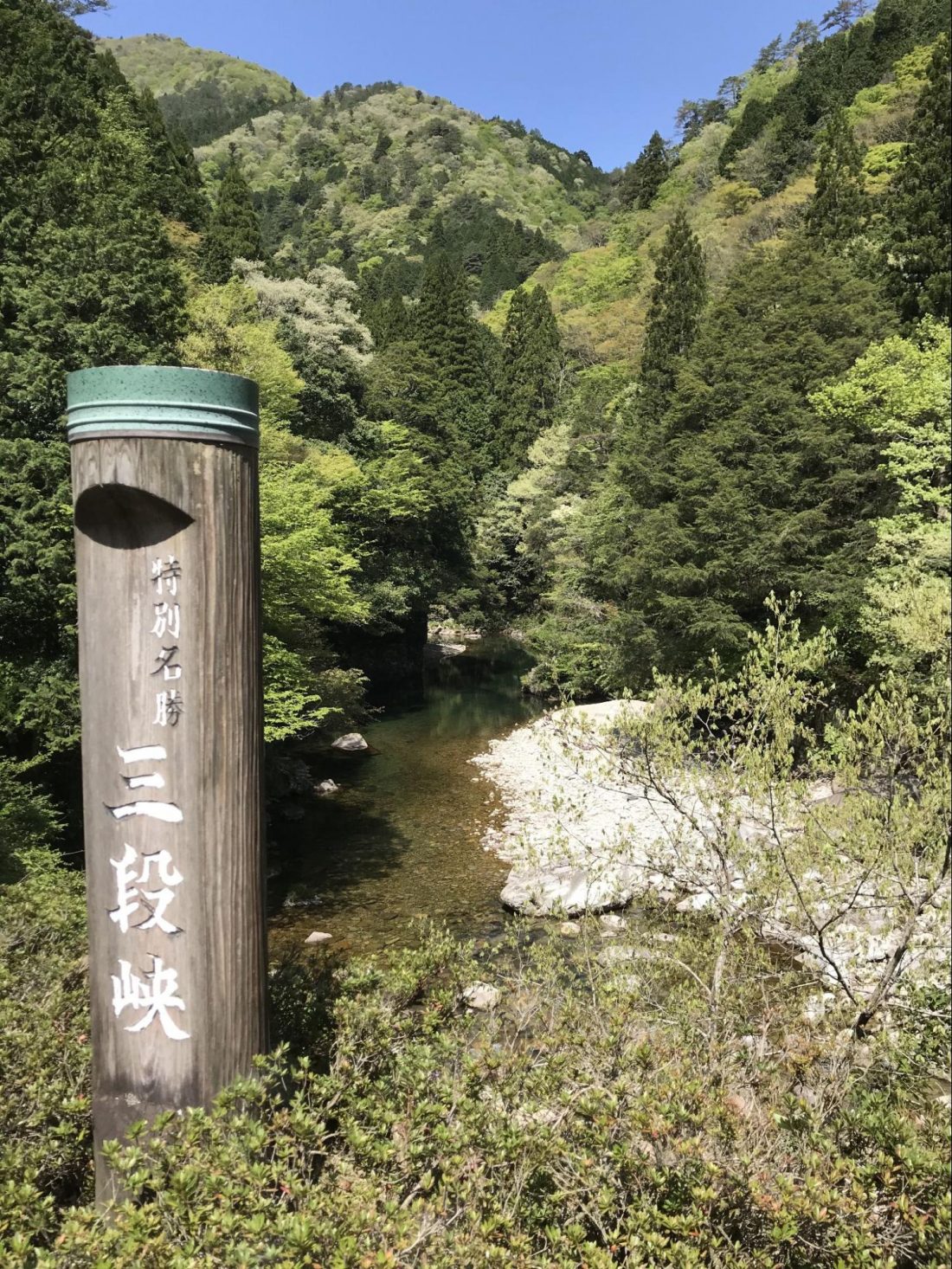
Entrance
Once you park at the Sandan-Kyo entrance you will see a couple of small shops, a combined hotel and local hotspring, some public restrooms, and information pamphlets (only in Japanese) located just in front of the entrance. From there you will enter the park (there is no fee to enter) by crossing a suspension bridge across a river, and turning left you will see a sign marking the entrance to the park (both in English and Japanese).
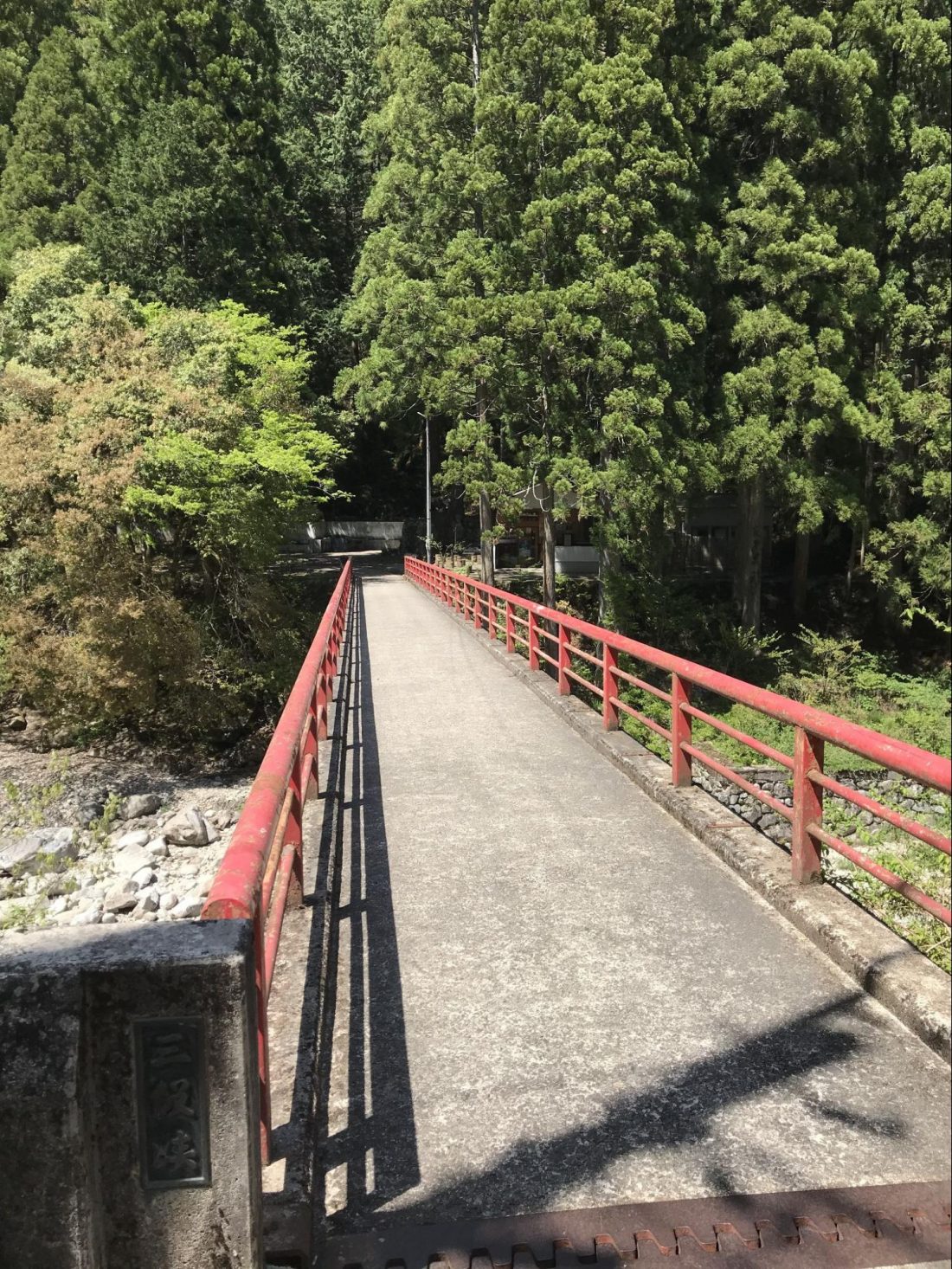
Moment of Joy
Once I arrived at the park entrance next to the Mizunashi Parking area, I came to the Nagabuchi Bridge and crossed over the clear flowing river below to enter the hiking trail and turned l toward the river to see the stunning, natural beauty of the gorge below me and the accompanying beautiful and bountiful surroundings. The initial view was quite magnificent and pleasing to the eye as well as the other senses upon first gaze. For me, it was a simple but poignant moment of pleasure to soak in the atmosphere.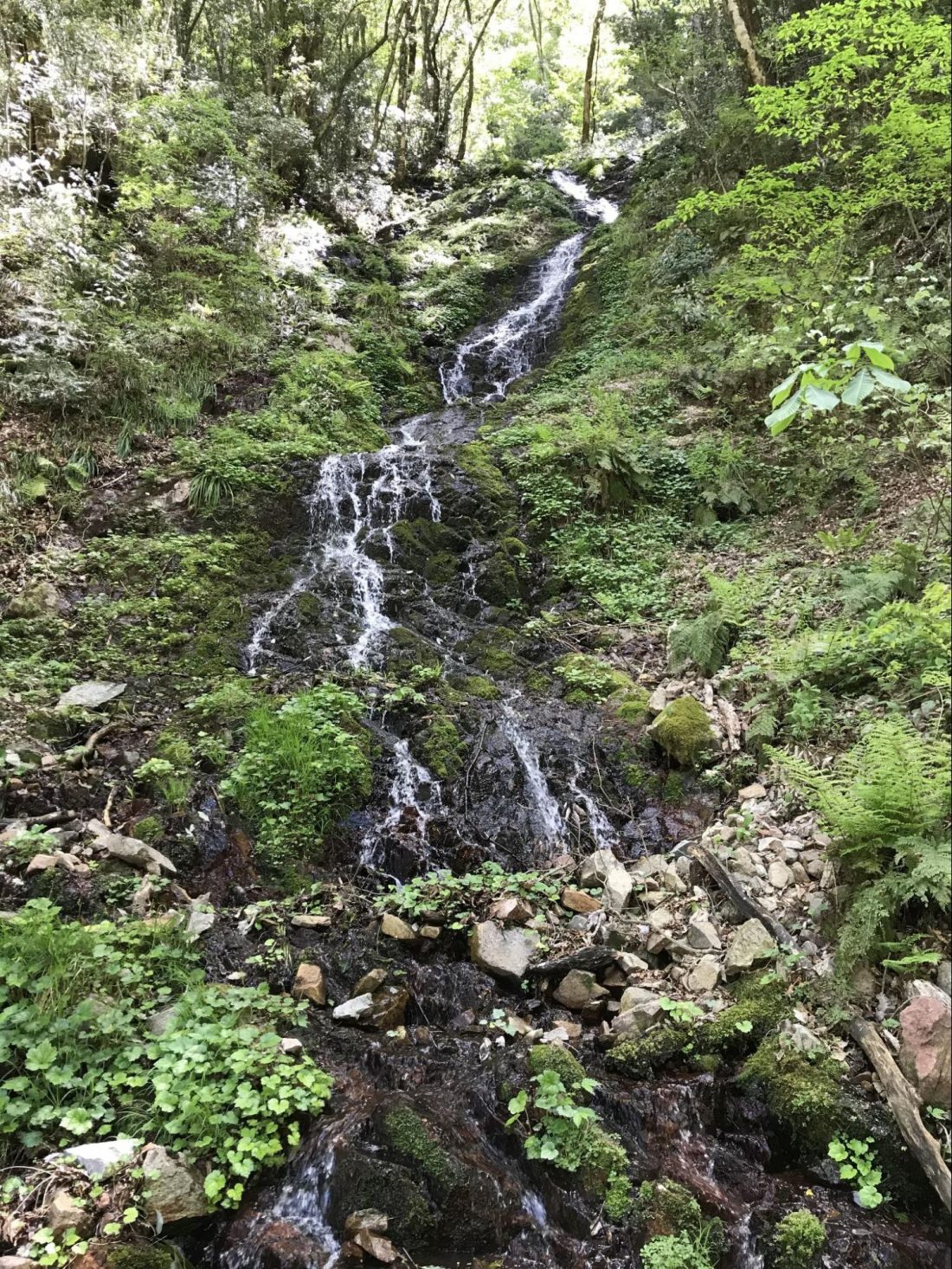
Trail
The gorge area covers about 13-14KM of hiking trail through (what I believe) some of the most beautiful natural landscape in all of Hiroshima Prefecture. The hiking area is open from late April until late November, but closed to visitors the rest of the year due to heavy snowfall.
Sandan-Kyo is considered a Japanese special place of nature, and was designated by the Japanese Government in 1953 as a notable place of natural and cultural beauty. The area covers a well designed and easy to follow trail all along the Shiwagi river; with views all along the trail encompassing a multitude of waterfalls, streams, pools, cliffs, bridges, and some of the more simply eye appealing natural views of nature in Japan.
The walking trail is well constructed with continuous river and gorge views as you walk along the road. All along the path you will be able to see the relatively pristine sights of your natural surroundings; mixed with an abundance of the local flora and fauna that fill up the area. The path is a bit narrow, but it is man-made and easy to traverse in either direction, which allows for traffic to move in both directions in and out of the trail. Some of the trail is surfaced with concrete and some is just well worn dirt and grass, so it is fairly simple to walk at a leisurely or brisk pace; and only a few minor steep inclines along the way to offer a bit of a challenge during your hike. The trail is recommended for all ages, with the distance and paths you travel decided by you and your fellow hikers based on your experience, health, and age.
It is an out and back trail that will take around 5-6 hours round trip, but you can hike only the portion you wish and cut down the time you are on the trail – as you desire. Along the way you will see a variety of hikers (individuals, couples, families, elderly, and young people) all enjoying a simple but elegant view of nature that will likely grab the attention of both your senses and emotions at the same time. For nature lovers, it should be a pure delight to experience such a beautiful area with a plethora of natural surroundings.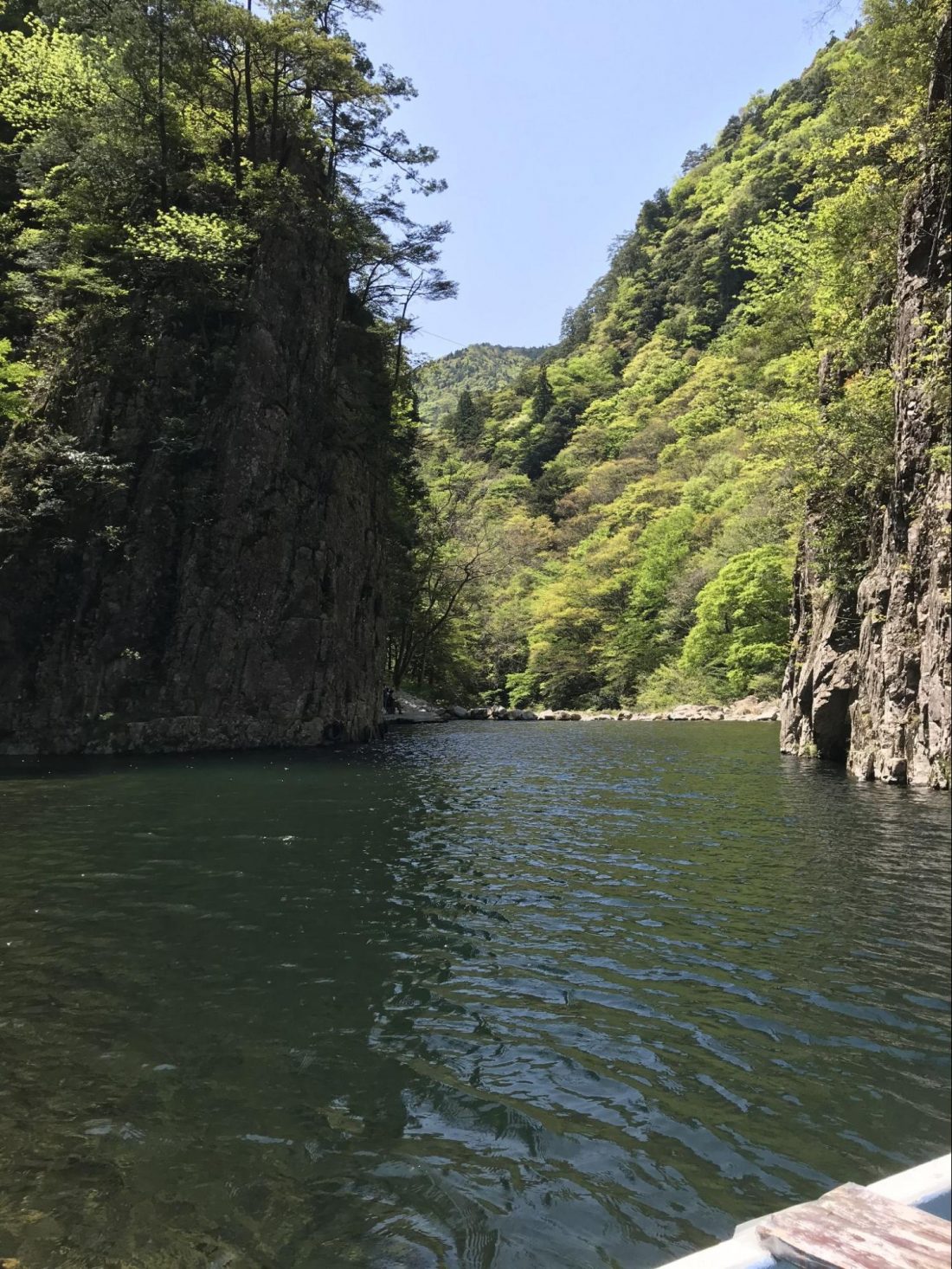

Highlights
As you move along on your hike, there is so much to see and take in that you will likely be consistently, and pleasantly be absorbed by what you see. By simply just looking down upon the river below with water so clear that the reflections in the sunlight, you will likely want to keep your camera or cell phone aimed and ready to produce some amazing images and photos. You will also see cascading waterfalls on both sides of you as you hike along – on the riverside and mountainside included. There are some scenic spots to stop at, including the Tatsunokuchi view spot about 2.5KM hike into the park (on your left along the riverside). 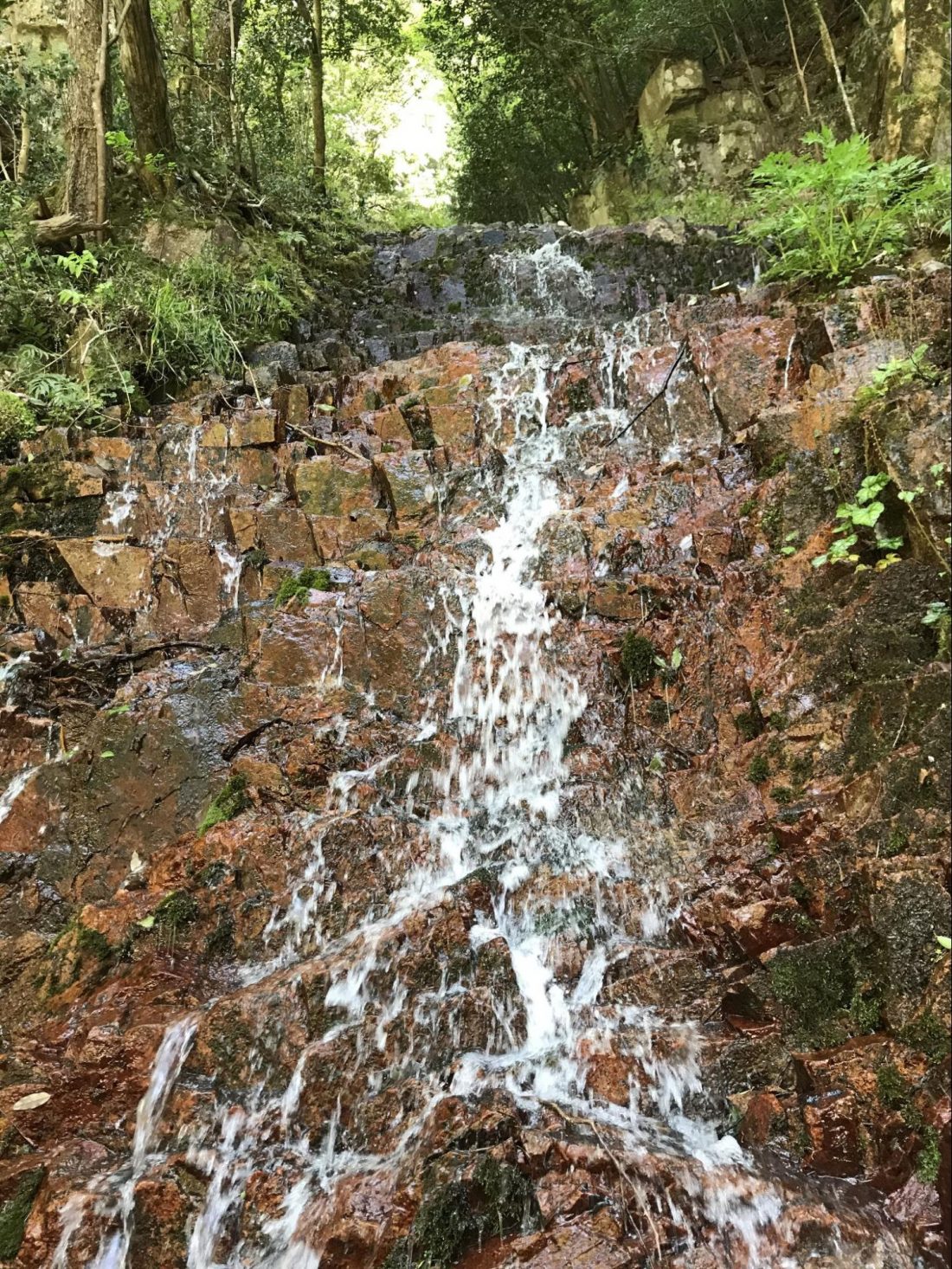
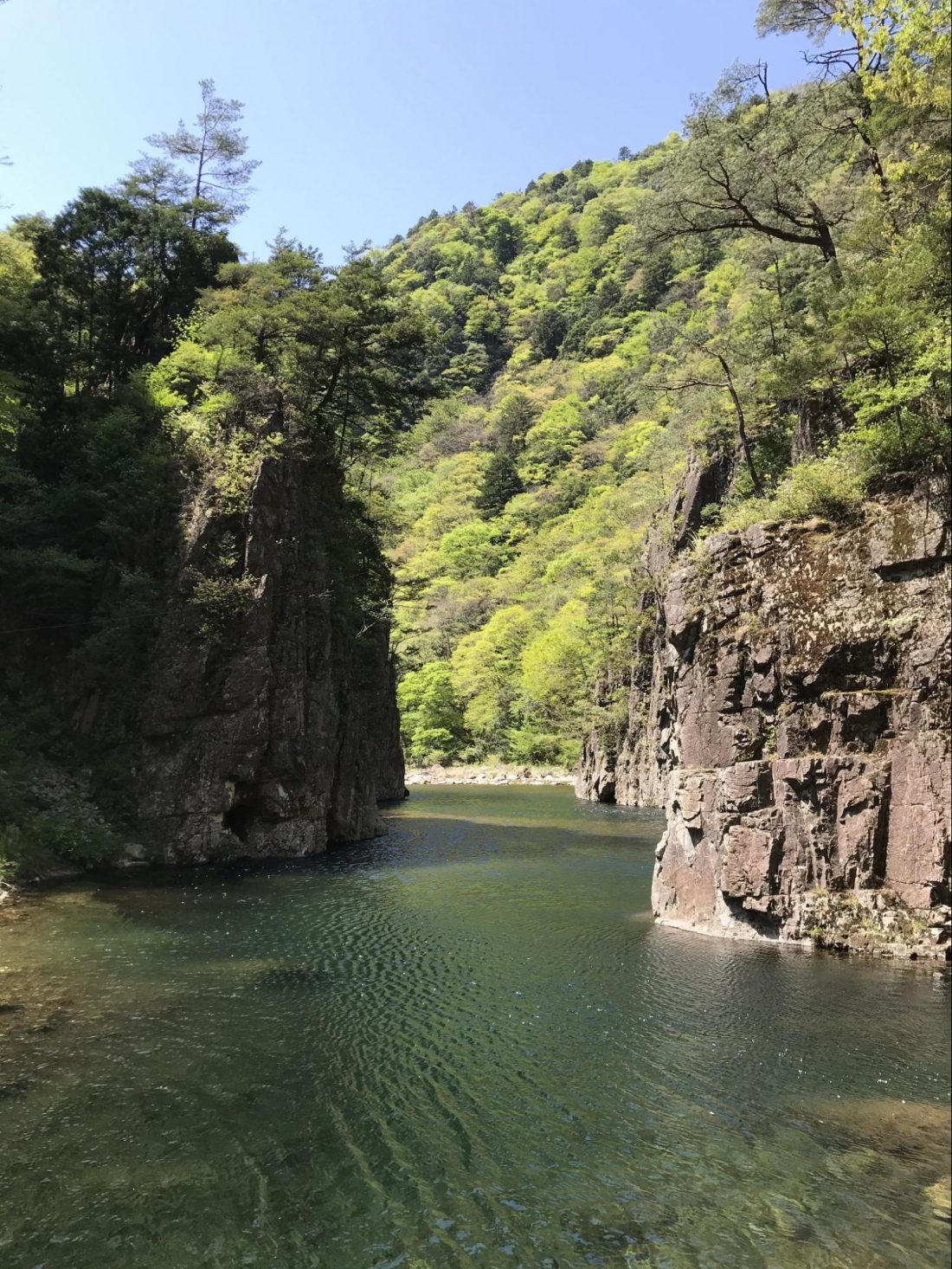
About another 3km hike or so into the trail you will come to an area known as Kurobuchi where you can take a ferry boat through a narrow passage for 500 yen (one way; 1000 yen for round trip) to a riverside restaurant/teahouse (Kurobuchi-so), that serves local fish and specializes in salmon from the area, and serves other offerings such as rice balls (onigiri) and other small Japanese local foods as well. If you do not wish to use the ferry, you can also walk to the restaurant area by going up the hill near the ferry and then cross a small suspension bridge (on your left) that will take you straight to the restaurant/teahouse (along the mountainside). This is also a good place to make a rest stop as there are public restrooms there for use.
Further along the trail you will come to the Mizunashi entrance. If you head west or to the left you will see the Nidandaki Waterfall area and can find the Osorakan Campground, which uses solar and hydro-power energy if you decide to take a rest or use the area to camp or have a picnic-style lunch. If you head north and east or right at the fork from Mizunashi, you will come to the Sadandaki Waterfall, and further along the trail about 4.5KM up the road you will arrive at Lake Hijiri and the Tarutoko Dam.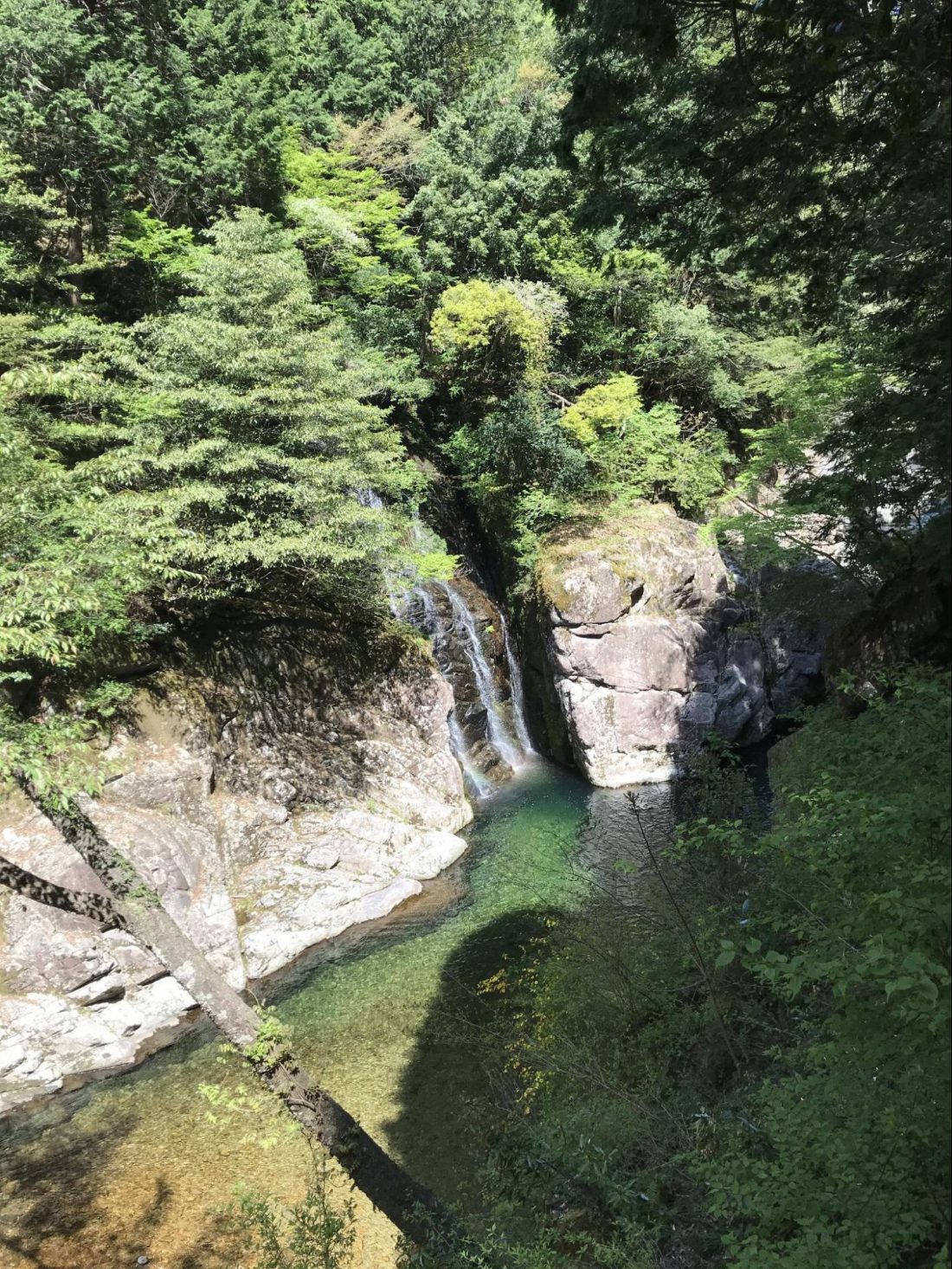
Most hikers enter the park at the main entrance near the Nagabuchi Bridge for a day hike, but there are three other entrances to the park: Sandan-Kyo Shinnyuzan Entrance in the northeast; Sandan-Kyo Yokogo Entrance to the west near the Osorakan Campground; and the Sandan-Kyo Hijiriko and Mochinoki Entrance in the northwest corner of the park. These additional entrances offer a variety of choices on where to start your adventure in Sandan-Kyo. Please see the above link (under the Togouchi Michi No Eki Interchange Rest Stop section) for the park area map to better guide you to these other entrances.
If you opt for the main Nagabuchi Entrance, and an out and back hike (either a full or half day trek) you will see so much of nature on both the way in and the way out that your sensory experience will surely be overloaded with the abundance of natural scenes that the park has to offer! You will just need to keep your eyes peeled for the many varieties of views that will most surely provide a strong and pleasant sense of the wonder of what nature can offer us all when we experience it!
Akiota Area Sights
As you return to the starting point (Nagabuchi Bridge in my case), you can exit the park (via car) the way you came in via route 249 and follow it east and north to route 191 via the Sandan-Kyo Fork that will split to the left. I recommend going here to go to the local fishing pond in the area called Keiryu Chaen (no English here; only Japanese). Just follow the road through the Mushigi Pass towards Matsubara and go left at the traffic light. The fishing pond (tsuribo) is visible on your right side. At this pond, you can get a fishing rod and a bucket to catch fish located in the stocked fish ponds. The cost is around 1000 yen for all you can catch (or 300 yen per fish if you only want to catch one or two fish). If you want the staff to cook the fish you catch, you can pay about 300 yen per fish (after paying the initial 1000 yen fee) – they will either grill or fry it for you (you can choose, and then serve it to you at a table. The pond restaurant also has noodle dishes and curry along with drinks such as beer and soda or tea (all for a fee) to compliment your daily fish catch!
Once done fishing, you can head back towards the Toguchi Interchange area and drive towards Kake. Here you will find a famous and delicious taiyaki (https://en.wikipedia.org/wiki/Taiyaki) restaurant called Taiyakiya Yoshio (no English only Japanese), which is a waffle/pancake batter filled with warm azuki beans, custard, or other tasty treats. The store is small, but the crowds were out the door about 15 people long when I went there on a Sunday. You can use your flip book and the appropriate QR code to find the location and put it in your cell phone or navigator in your vehicle. It is about a 10 minute drive from the park entrance. The taiyaki was very tasty and worth the drive to get there!

The Sandan-Kyo hiking/camping trail located in the Akiota area of Hiroshima Prefecture is simply a wonderful place to spend your day with what the natural surrounding has to offer, and to leave behind the big city for a period of exercise, a time to absorb what nature has to offer, and to fill your senses with joy, as well as to give you some time for reflection and thinking that will likely offer a positive contribution to your overall health. This place is a must see in my book. I hope that if you have the time and desire, that you can visit the Sandan-Kyo area!

